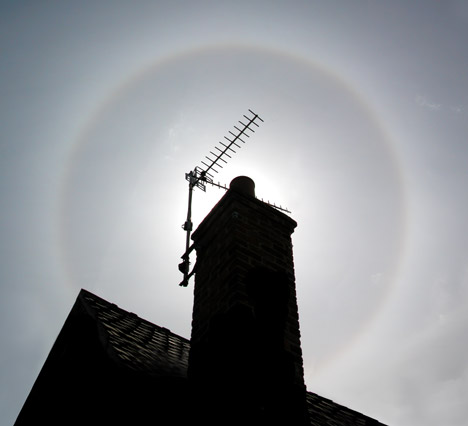
OPOD
What's New
Rays & Shadows
Water Droplets
Rainbows
Ice Halos
Contents
Crystals
Frequent Halos
22° circular
Formation
Disk in the sky
Random xtals?
Moon Halos
More Images
Sundogs
Tangent Arcs
Circumscribed
Pillars
Circumzenithal
Circumhorizon
Parhelic Circle
Infrequent Halos
Multiple Displays
Other Worlds
Observing Halos
HaloSim
High Atmosphere
Links & Resources
Search - Index
123456789012345678
| 22 degree Halo |
 |
Millions of ice crystals glint down from 3 to 5 mile high cirrostratus haze to form the 22º halo. The sharp inner edge is red tinged. Beyond, the halo fades gradually away. The sky Inside is dark because no crystals there can glint towards the eye. Photo ©Les Cowley. |
| 22º radius halos are visible all over the world and throughout the year. Look out for them (eye care!) whenever the sky is wisped or hazed with thin cirrus clouds. These clouds are cold and contain ice crystals in even the hottest climes. | ||
The halo is large. Stretch out the fingers of your hand at arms length. The tips of the thumb and little finger then subtend roughly 20�. Place your thumb over the the sun and the halo will be near the little finger tip. The halo is always the same diameter regardless of its position in the sky. Sometimes only parts of the complete circle are visible. Much smaller coloured rings around the sun or moon are a corona produced by water droplets rather than ice crystals. Does it foretell of rain? Not necessarily. High cirrostratus cloud forms the halo and this same cloud can be on the advancing edge of a warm front with its associated heavy rain. If a wind stirs from the south west, the sky becomes hazy, a halo forms around the sun which is then dimmed and finally obscured by increasingly thick cloud then rain is likely within a few hours. But very many halos are not associated with frontal systems and to see one is not at all a reliable sign of wet weather. When looking for halos always shield both eyes from the sun. Never stare close to it even for a moment. Preferably, hide the sun behind the edge of a building or post. Take care when photographing halos if the unshielded sun is in the field of view. It is dangerous to look at the sun through some camera viewfinders, especially SLRs - do not take risks! Tips on eye care. |
 |